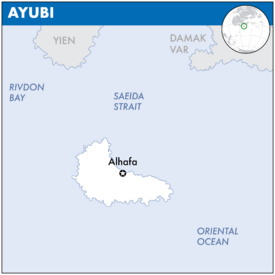Ayubi
Kingdom of Ayubi Ayubi (Sahrabic) Joe Bobs (Anglish) | |
|---|---|
 Map of Ayubi | |
| Capital | Alhafa |
| Demonym(s) | Ayubid |
| Government | Unitary parliamentary absolute monarchy |
• Sharif | Yusuf Althudiyu |
| Legislature | National Congress |
| Establishment | |
| 15th Century | |
• Independence | 1692 |
• Current constitution | $Year |
| Area | |
• | 53,751 km2 (20,753 sq mi) |
| Population | |
• 2015 estimate | 1,303,569 |
| Currency | Ayubid dinar |
| Date format | MM/DD/YYYY |
| Driving side | left |
The Kingdom of Ayubi (Sahrabic: الأيوبيون) is an island nation in the south of Europa on Eurth. The country is situated off the southern coasts of Mahdah and Damak Var. It consists of many small islands and one large: Jawin, the main island. The capital is Alhafa, located on the north side of Jawin. The Ayubid economy is heavily dependent on tourism and the export of spices. In particular, the islands produce black pepper, nutmeg, and cinnamon. It has a land area of 53,751 km2 and is densely populated, with a total of 1,303,569 inhabitants at the 2015 Census.
Etymology
The name Ayubi comes from the progenitor of the Ayubid dynasty, Yusuf Ayub ibn Mustaf, a prince of the Mahdavian royal house. Yusuf conquered the island of Jawin in the 15th Century, after a bloody struggle against the expanding Orioni empire.
Geography
The islands are separated from the Azanian mainland by the Strait of Saeida. The main island Jawin is about 394.75 kilometres long and 150-200 kilometres wide, with an area of 53,751 km2. Ayubi is characterised by beautiful sandy beaches with fringing coral reefs. The reefs are rich in marine biodiversity. Being near to the equator, the Ayubid islands are warm year round. The heat of summer is often cooled by strong sea breezes. This climate has helped tourism as visitors to the island can reliably expect warm, sunny weather.
The capital Alhafa (Sahrabic: الحافة; Oharic: Chafu) is a port city on the northeast coast. The city is located on the shores of the $Name Sea opposite Damak Var. Alhafa was an overseas possession of Orioni from the 15th to 18th Century. For most of its history, Alhafa was a small settlement with an economy based on fishing.
History
Pre-colonial era
The discovery of microliths on Ayubi suggests that humans arrived around 40 KYA. The early history of Ayubi is closesly tied to other regional powers in Azania, notably Mahdah, Hakenium, Sa Hara also Jilderen The first people were probably fishermen. Traces of fishing and dugout canoe production also exist. An Aroman scroll from the 2nd Century CE mentions the island of 'Jazirat Jawin'. There is some limited evidence of long-distance trade: pottery fragment from Aroma have been found, mostly dated to the late 4th century CE. The coastal towns appear to have been engaged in local trade. Trade grew more important from the 8th century. By the 9th century Ayubi was one of the final links in the Pearl Road.
Colonial period
During the Age of Reconnection in the 15th Century the Orinese arrived in Azania. On Ayubi they found a series of independent towns on the coast, with Salamic Sahrabic-speaking elites. The Orinese travelers described them as 'dark skinned'. A clear distinction was made between the Salamic and non-Salamic populations. Relations with local leadership were mostly hostile. The Orinese ruled with the aid of tributary sultans. The Orinese presence remained relatively limited, leaving administration in the hands of preexisting local leaders and power structures.
Independence
This system of subservience lasted until the late 17th Century. In September 1692 the Sultan Mustaf of Mahdah commanded his second son Prince Yusuf Ayub ibn Mustaf to lead the wholesale invasion of Makkuran. The prince began a military naval campaign against the foreign oppresor, winning early victories by conquering some coastal villages. He encountered no strong resistance. In March 1693 the decisive battle was fought at Alhafa between the Ayubid force and the mercenary army of the Orinese Viceroy. The Prince's army included war elephants and solidly defeated the Orinese. When the capital was captured the troops rampaged and massacred many of the Orinese inhabitants. Captured booty was distributed among the soldiers. The new ruling dynasty replaced the existing power structure and developed an economy of trade and cash crops. Plantations were developed to grow spices.
20th and 21st centuries
Politics
The current ruler of Ayubi is Sharif Yusuf Althudiyu. He is a member of the House of Ayubi, which in itself is a cadet branch of the House of Mahdah. Prime Minister $Name is leader of the executive branch. The National Congress is the legislative body of Ayubi.
Economy
Ayubi underwent major development from 2006 to 2014. In 2006 the Ministry of Transporation began construction of a coastal highway. In 2008 the Government of Ayubi began the expansion of Alhafa Port into a modern deep-sea port. The first phase of this project was completed in December 2011, the second in 2014, and it became fully operational in 2017. Orioni has been instrumental in the project, providing nearly 75% of the construction budget in the form of loans. Orioni is heavily dependent on Rivdon Bay oil which passes through the Strait of Saeida.
Demographics
Culture
The flag consists of solid green background. A white star with seven points is featured in the centre. The star stands for unity. Its seven-points refer to the seven verses of Al-Fatiha. Each point has a special meaning: faith in one God, humanity, humility, national spirit, virtue, social justice, and aspiration.



